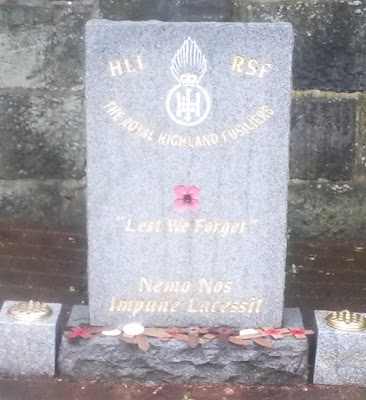 |
| Glasgow Necropolis |
 |
| Glasgow Cathedral from the Necropolis |
 |
| Glasgow Necropolis Entrance Gates |
 |
| Glasgow VC Memorial |
 |
| Glasgow Royal Highland Fusiliers Memorial |
Serving with the 1st Commonwealth Division at various times during the War were a number of Scottish Regiments:
1st Battalion, The King's Own Scottish Borderers, July 1951 – August 1952
1st Battalion, The Royal Fusiliers, August 1952 – July 1953
1st Battalion, The Black Watch, June 1952 – July 1953
1st Battalion, The Royal Scots, July 1953
 |
| Glasgow Korean War Memorial |
 |
| Glasgow Necropolis Plan |
The main cemetery is reached by crossing the Molendinar Bridge which leads to the Façade.
 |
| Glasgow Necropolis Molendinar Bridge |
 |
| Glasgow Necropolis The Façade |
The most notable casualty is Lieutenant General Sir James Moncrieff Grierson who died of heart failure 17th August 1914 whilst commanding II Corps of the British Expeditionary Force. Grierson was commissioned into the Royal Artillery in 1877 and saw action in during the Anglo-Egyptian War (1882) and the Sudan Expedition (1885). He served as Brigade Major Royal Artillery from 1895 to 1896. His next appointment was a Military Attaché to Berlin allowing him to gain a good knowledge of the German Army. Active Service followed in the Boxer Rebellion (China 1901) and the Second Boer War (1899-1902). After series of staff appointments, he was appointed GOC 1st Division in 1906, and GOC-in-C Eastern Command in 1912.
 |
| Lt.Gen. Sir JM Grierson |
On mobilisation of the British Expeditionary Force on 4th August 1914 Grierson was commanding II Corps (3rd &; 5th Divisions). He deployed to the continent, but died of a heart attack on a train near Amiens on the evening of 17th August 1914 before the BEF had engaged German troops.
His body was repatriated and buried in a family grave in Glasgow Necropolis Primus 38.
 |
| James Moncrieff Grierson Glasgow Necropolis Primus 38 |
Another casualty interned in the Glasgow Necropolis is Major Norman Macleod Adam MC Royal Field Artillery. He was killed in action 28th August 1918 near Fontaines-les-Croisilles, Arras, in France.
He was buried in France in line with the Imperial War Graves Commission principles. His CWGC record details the body was secretly exhumed 20th June 1922, brought to Glasgow and interned in a family vault in the Necropolis Omega 248, 4th July 1922.




























